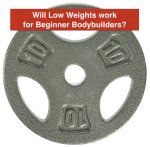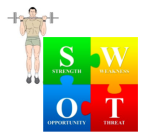Muscle Building Anatomy for Skinny Guys to Gain Mass
Discover Simple Muscle Anatomy Secrets that will make every workout super-effective and skyrocket your Muscle Gains.
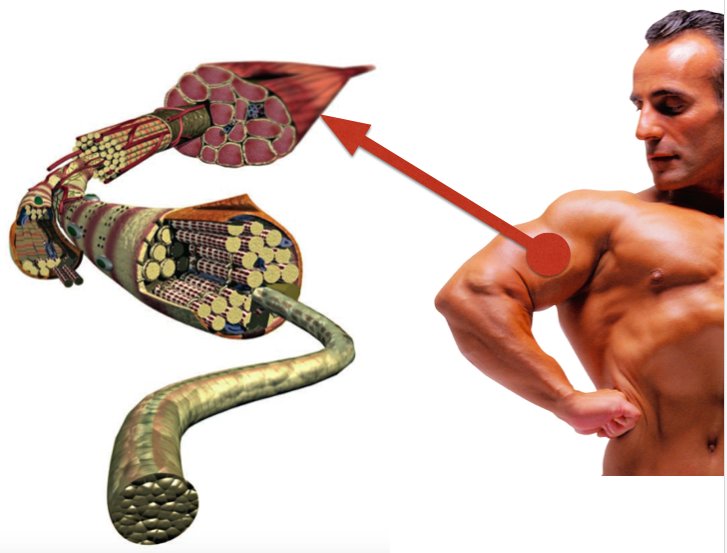 Do you know what happens inside your muscles when you train or eat? Find out now.
Do you know what happens inside your muscles when you train or eat? Find out now.Here's What you need to know:
- Muscles are the prime movers of your body; they help create movement. Basic muscle anatomy will help you understand the fascinating inner workings of your muscles.
- Major Muscles of your Body hold maximum growth potential. Find their main functions and SINGLE BEST exercise to target them.
- Muscle Size principle and how muscles cheer each other are concepts for smart muscle builders and help you activate muscles for mass and strength gains.
In This Article:
- What every bodybuilder should know about muscle anatomy
- The Muscle anatomy 101 - and how muscles contract
- Your muscle fiber types and their growth potential
- Major muscles, their functions and single best exercise
- Muscles and brain - partners in movement
- The Principles of muscle recruitment, irradiation and how muscles Cheer each other
- Summary and 5 key points
What every bodybuilder needs to know about muscle anatomy
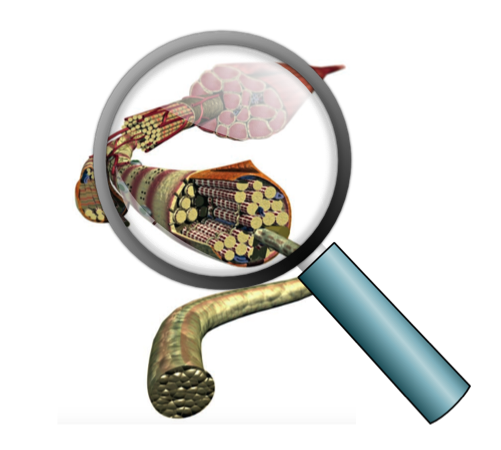 Knowing Inner Workings of your muscles will help you train them effectively
Knowing Inner Workings of your muscles will help you train them effectivelyWould you drive a car without knowing the gear box, the gas pedal or the ignition?
Then why do most muscle builders start training without knowing basics of muscle anatomy?
In a rush to build muscle most try whatever program they feel promising, take unproven supplements advertised in a magazine and wonder why muscles fail to grow at all!
But the real muscle secrets lie under your own feet. Its called
- Basics of muscle anatomy Or Muscle fiber structure and
- Muscle Physiology or How muscle grows
I cover how muscles grow in a different article. This article concerns with muscle structure.
My own results skyrocketed after I learn these fundamentals. Once I discovered the secrets below, I was able to analyse a program easily, make a rock-solid plan myself and make course corrections till I was able to build my dream body.
Sure I learnt from experts, but without the muscle fundamentals it would have taken much longer time.
Muscle Builders! Know your muscles!
Would you not like to know what's happening inside your body when you train? After you eat meals? Or when you sleep?
Your muscles undergo various changes during and after training. And what you eat or fail to eat can have a dramatic impact on your muscle building outcome.
But what is muscle made up of?
The language of muscle is TENSION but to know how it generates tension you need to know its structure.
Muscle Anatomy 101 or How Muscles Contracts

Did you know muscles make up 40% of your body mass?
There are over 650 of them and all have one purpose - to help you move as efficiently as possible.
Walk, run, eat, laugh, squat, press or simply turn, your muscles are in action.
They do this by generating power moving bones across joints in varying planes. So your muscles, bones and joints are partners in movement.
At a micro-level muscles are made up of water, proteins and glycogen {stored glucose}. Their cell membranes are made up of lipids or fats.
As cell is the functional unit of our human body, muscle cells are th basic units of muscles.
Each muscle is made up of thousands of individual muscle cells called muscle fibers which are arranged in bundles. And these bundles make up the muscle itself.
The smallest contractile unit of muscle fiber is called Sarcomere. It is made of proteins and is of great importance as adding proteins to the sarcomeres make you strong and big. All your dietary proteins go to your sarcomeres.
When you do that jaw dropping biceps curl, it is the sarcomere at the smallest level that contracts, and thousands of them contract to cause your biceps contract. Each sarcomere is made up of two proteins - actin and myosin, the basic proteins involved in muscle contraction.
Each muscle fiber bundle and the muscle itself is surrounded by connective tissues called fascia which help all of the muscle proteins stay together and create very stable structures.
Notebar : Large muscles like the hamstrings have large bundles with lots of big fibers. Small muscles like those of hands had small bundles. Whatever the size, each bundle is triggered by one stubble nerve which calls the shots.
Each motor nerve work all the muscle fibers or innervates is called a motor unit. More on this later.
What does fascia do exactly?
They provide elasticity.
Just like rubber bands recoil when elongated, your muscle fascia will stretch and recoil {Stretch-shortening cycle} providing you that amazing ability to contract biceps harder in a biceps curl exercise.
In a future article I will explain a special technique called prestretching which you can use to improve strength instantly .
Note for muscle nerds: The process muscle contraction and its molecular mechanism is too complex and not needed for you. It is explained by the sliding filament theory of skeletal muscle contraction proposed by two physiologists Hugh Esmor Huxley and Emmeline Jean Hanson. I have included a link at the end for more information on the theory.
Muscle Fiber Types - The Hidden Key to Fast Muscle Gains
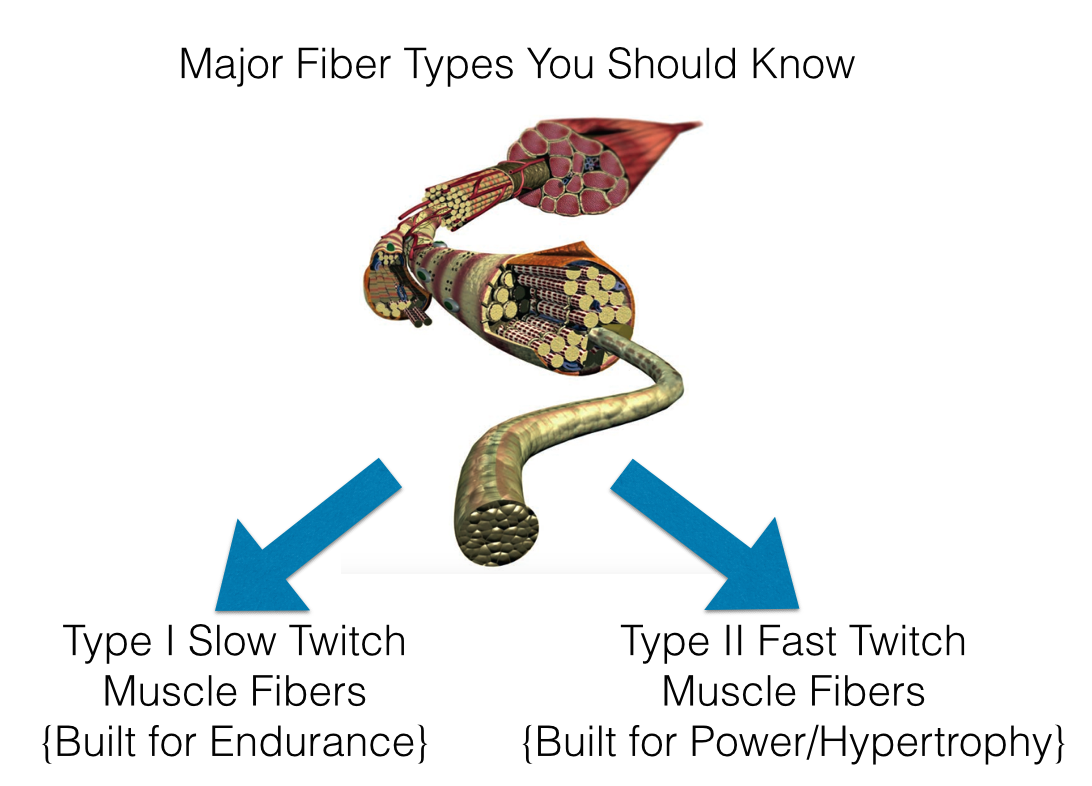
How does some weired muscle fiber lesson in physiology help you build muscle? {2}
I thought so too. But very soon you will realize how knowing fiber types can help you selectively target fibers with highest growth potential and gain muscle faster.
Here's how:
Deep within the nucleus of your muscle fibers resides the DNA material which decides your exact muscle building potential.
It decides how much muscle you can gain and how fast. {It decided you height, your eye color, skin color etc}
Your each muscle fiber has multiple nuclei and each nuclei regulates a portion {cytoplasm} of the fiber.
The DNA also sends signals for both muscle repair and hypertrophy via protein synthesis. Proper training, nutrition and recovery creates an anabolic environment that stimulates protein synthesis. Hormones like testosterone and growth hormone released during/after exercise also stimulate protein synthesis directly.
All muscle fibers have same basic structure, But first:
Have you wondered how different a body of a marathoner looks from a bodybuilder or a sprinter?
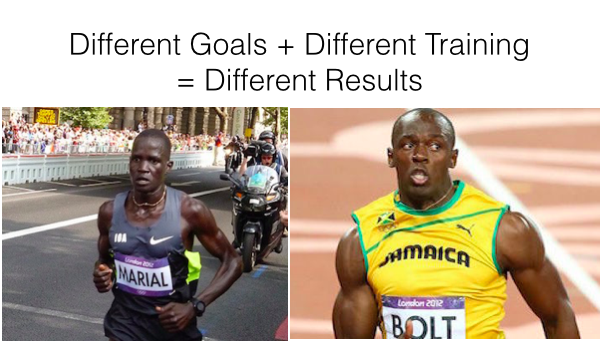
The marathoner has abundant type I Muscle fibers and the bodybuilder and sprinter have abundant type II Muscle fibers.
Partly genetic variation but mostly the difference is due to way they train.
They train different muscle fibers preferentially
Basically you have two types of muscle fibers - Type I, slow-twitch fibers, and Type II, fast-twitch fibers
Type I fibers have high aerobic {oxidative} capacity, high endurance and can work for hours - excellent for marathon work.
Type II fibers have anaerobic {glycolytic} capacity, are made for strength and power - excellent for heavy lifting and sprinting.
Your ability to target High Threshold type II muscle fibers with high intensity, high volume training IS THE KEY TO BUILD FAST MUSCLE MASS.
Major Muscles of Your Body and some Key Terms
There are 600 muscles in your body, all different in size, shape and functions, but all designed for one function - move your joints in the different directions or planes that they are designed to move in.
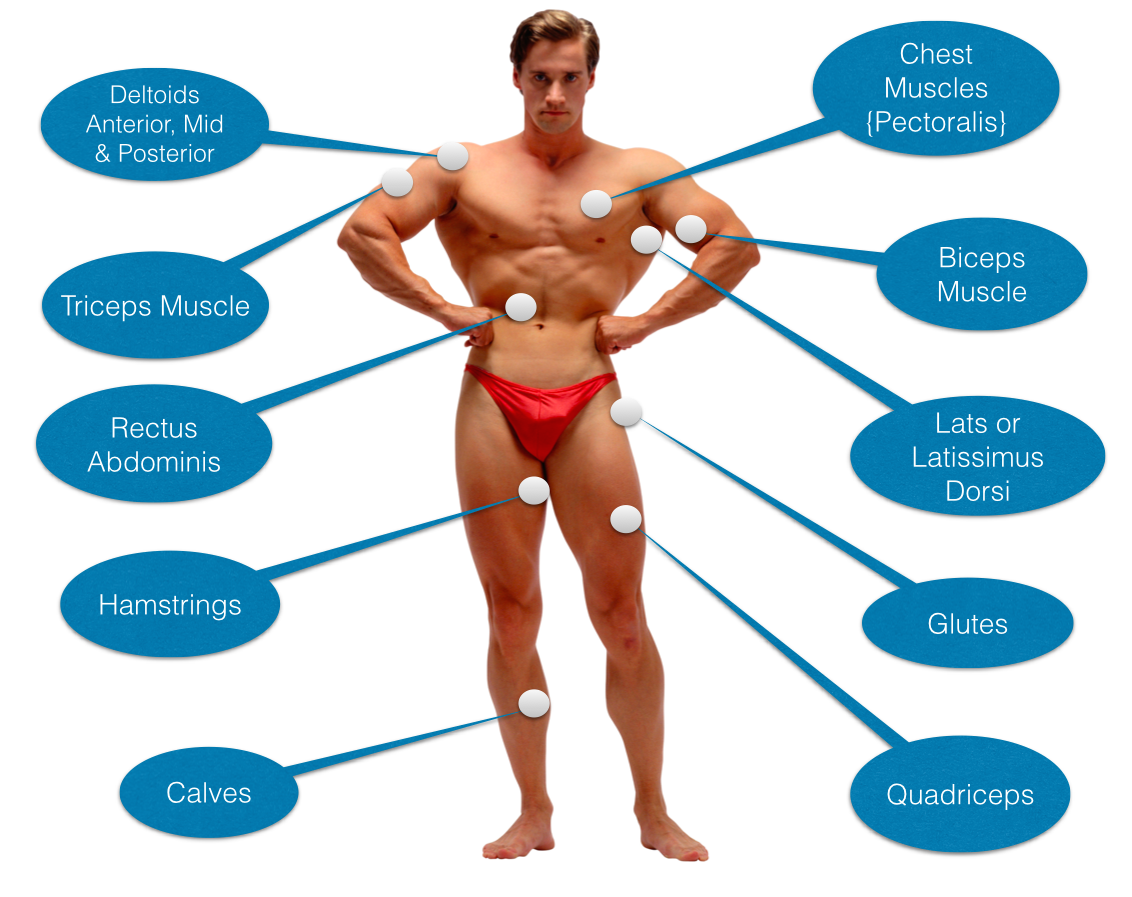 Major Muscles of Your Body {Front View}
Major Muscles of Your Body {Front View}Here are the salient features of your muscles:
a. They got Joints: Some are hinge joints like keep and fingers which also movement in one plane only - namely flexion and extension. Exercises like knee extensions work them.
For example have a look at your shoulder and hip joints. They move in multiple planes. Not only they can flex and extend, but they can abduct, adduct, even rotate. Exercises like Squats, upper body presses, pulls and flys target them.
b. These muscles come in pairs, each opposing the other. There are knee extensors and knee flexors. During movement, one group contracts and opposite group relaxes.
c. Agonists are muscles that are prime movers of the joint in that particular direction.
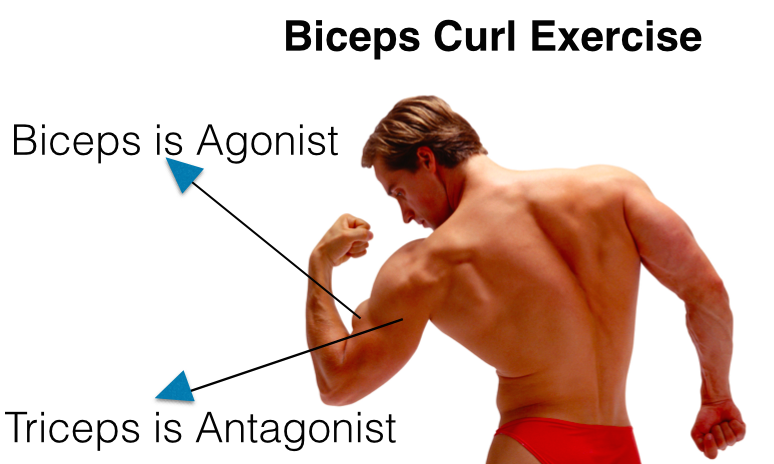 Agonist contracts & antagonists relax to create movement.
Agonist contracts & antagonists relax to create movement. Synergists are muscles that assist in movement and
Antagonists are muscles that oppose the movement
For example: In the biceps curls exercise, the biceps brachii and the brachialis are the agonists; brachioradialis is a synergist, whereas the triceps brachii is an antagonist muscle.
d. Concentric, Eccentric and Isometric Contractions
Concentric, also called positive muscle actions result when a weight is lifted and muscles shorten to produce force
Example: When you lift weight in bench press or biceps curls
Eccentric or Negative muscle actions or yielding results when a weight is lowered and muscles lengthen to produce force.
Example: When you lower weight in bench press or biceps curls
Isometric or static muscle action results when a weight is held in place stationary and no joint movement occurs.
Example: Pushing against a wall, holding dumbbell in space stationary etc
e. Muscles can have more than one origin and insertion points. Hence trained using a variety of exercises.
f. Muscle can have multiple heads, each head more active in a particular angle of an exercise.
For example, biceps brachia has two heads and triceps brachia has 3 heads.
The last two points are the reasons bodybuilders got a plethora of exercises, each designed to target specific heads, angles or points of attachment of muscles.
In the muscle building exercises section I will give you the best total body exercises and best specialisation exercises for each muscle group. But for now, lets get back to major muscle functions.
Major Muscles, Main Function and Single Best Exercise
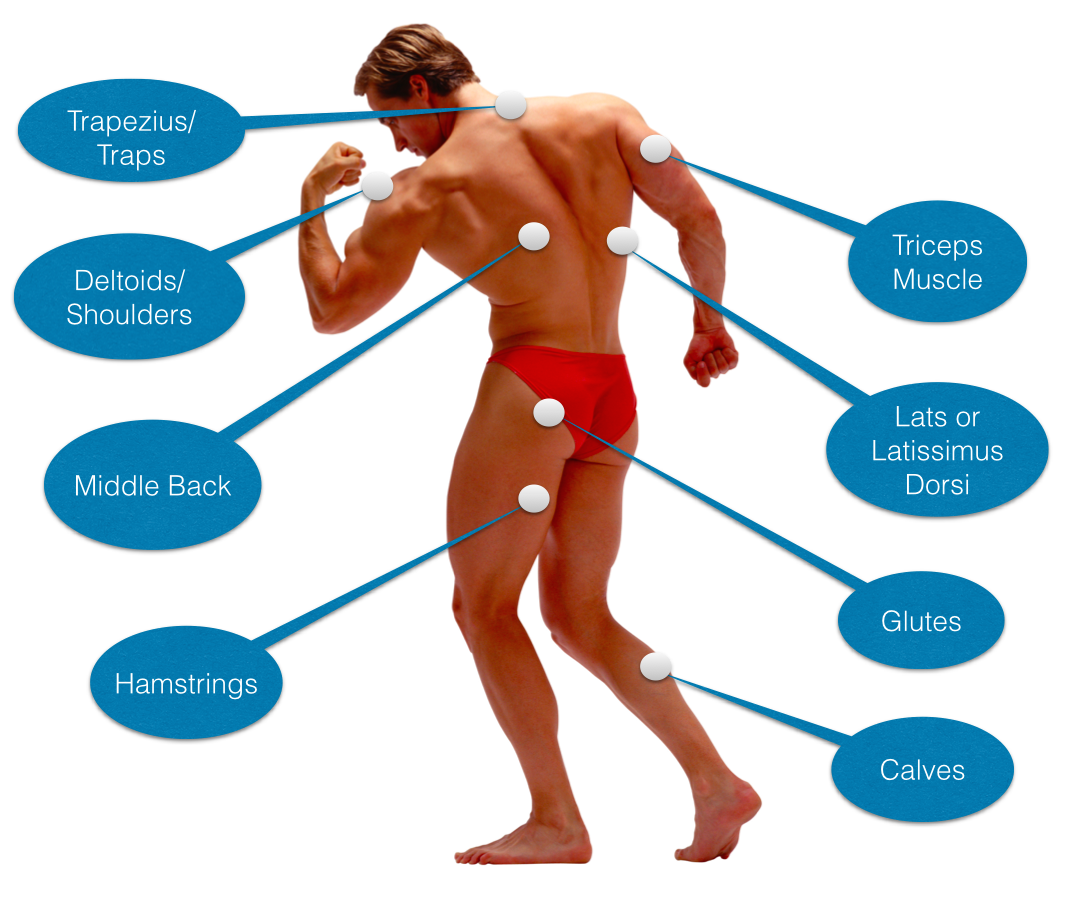 Major Muscles of Your Body {Rear View}
Major Muscles of Your Body {Rear View}Ready for some aha moments? Electromyography {EMG} studies have shown the most effective exercise for every major and minor muscle of the body.
By recording every exercise via EMG, exercise physiologists have proven which muscles are most active during exercises.
| Major Muscle | Main Action | Single Best Exercise |
| Deltoids |
Raises and rotates arm in all directions |
Seated Front Dumbbell Press |
| Pectorals{Chest} | Brings arms towards chest |
Decline Dumbbell Bench Press |
| Biceps Brachii | Bends elbow and moves forearm | Preacher Curls |
| Triceps Brachii | Extends elbow and moves forearm | Lying Triceps Extension {Decline} |
Lats |
Brings shoulders and arms back to body | Bent over Barbell Rows |
| Quadriceps | Extends Knee | Squats |
| Hamstrings | Bends Knee | Standing Leg Curls |
| Calves | Raises heel when leg raised | Donkey Calf Raises |
| Trapezius | Elevates and lowers pectoral girdle | Behind neck Barbell Shrugs |
| Rectus Abdominis | Brings trunk forwards | Incline Crunch |
| Gluteus Maximus | Brings hip forward |
Hip Thrusts Deadlifts |
Muscles and Brain - Partners in Movement
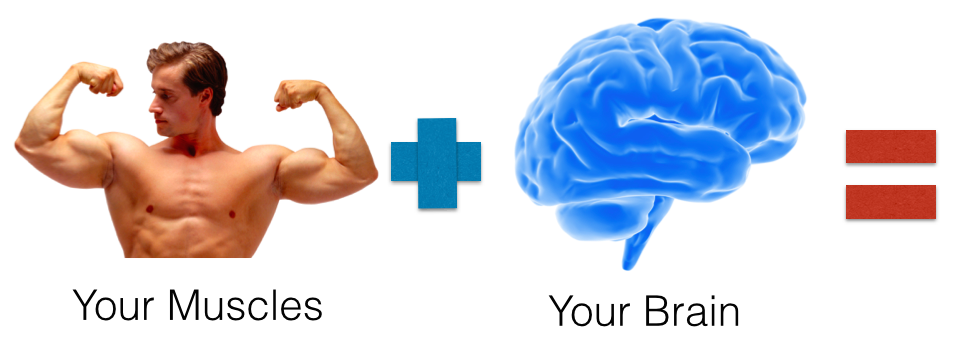
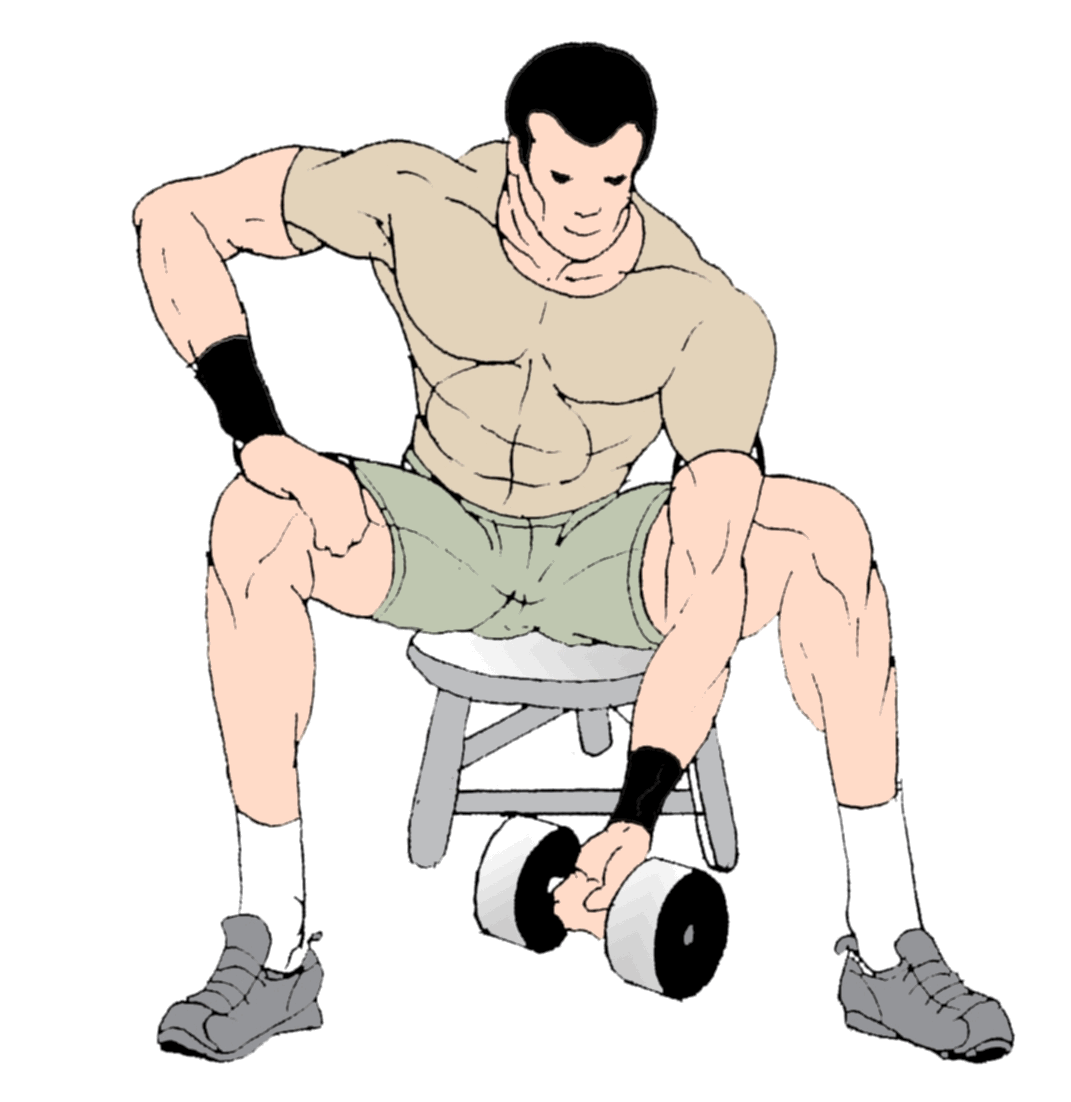 Muscles and Brain creates Action!
Muscles and Brain creates Action!How do your muscles contract?
Guess what you did before you picked up the barbell to perform the biceps curl?
You made an intention in your mind, even before you made any move!
That intention sent neural signals to the brain and back to the working muscles that an action is intended.
Blood moved into your muscles, lungs started to breathe heavier to pump more oxygen, muscles of your trunk provided stability and you lifted the barbell in one smooth motion.
Good job!
But real action happens inside the muscles.
As soon as you begin the curl, your muscles perceive the load, generate tension and start shortening. Tension is the language of muscle.
Your sarcomeres start shortening, the two protein filaments myosin and actin slide over each other {hence the name sliding filament theory} and the muscle shortens.
This is muscle contraction in a nutshell {concentric/shortening muscle action}.
As you start to bring the weight back to initial position, your biceps start lengthening and going back to initial position.
The sarcomeres lengthen, myosin and actin filaments slide back to initial position and muscles lengthen {eccentric/lengthening muscle action or yielding portion of an exercise}.
That in a nutshell is how muscles contract and relax. I just saved you one huge chapter medical students or exercise science students have to learn to pass exams!
No its time to maximise each fibers growth potential with,
Muscle Building "Motor Size Principle"
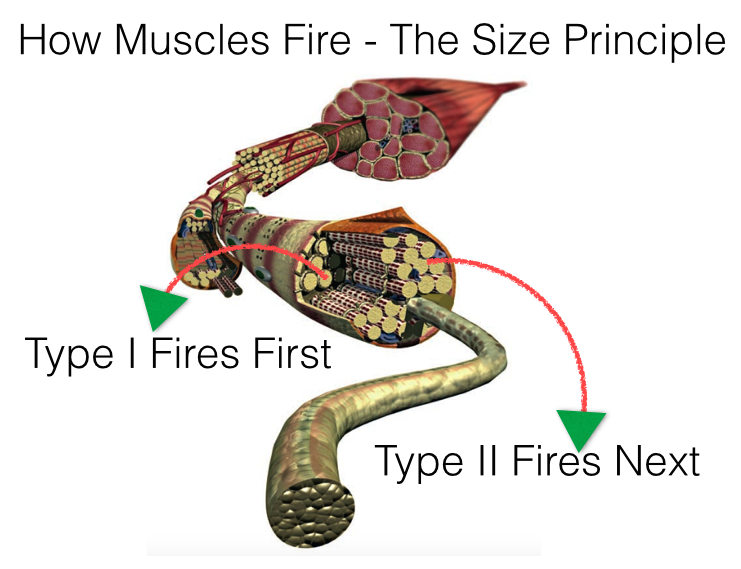
Ever seen a street fight? Two guys high on temper on fire. Don’t worry, local policeman will control the situation.
But what about a mass riot? Local police may call in for some extra help. They may call special task force, maybe SWAT.
Your muscles operate using similar principles.
The size principle states that,
"Motor units are recruited from the smallest to the largest based on the force demands placed on the muscle".
So what' the difference between lifting a broomsitck vs lifting a 100 pound dumbbell?
Why the weights Of course!
But what changes inside the muscles? And how can you use this information to build size?
This is called the motor size principle and it is the key to massive size and strength gains.
The Broomstick lift:
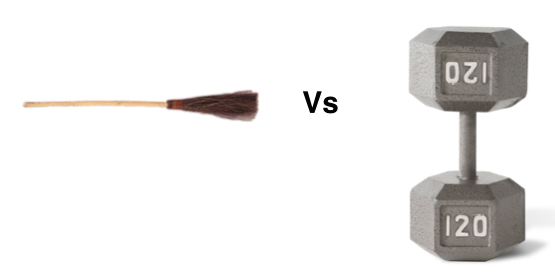 Broom or Dumbbell, which lift generates more tension?
Broom or Dumbbell, which lift generates more tension?Recall the motor unit.
Small motor units, called low threshold motor units are a combination of small muscle fibers and a small neuron supplying them.
Large motor units, called high threshold motor units are a combination of large muscle fibers and large neuron or nerve supplying them.
Small motor units generate little tension and large motor units generate lot of muscle tension {tension = muscle growth}
When you lift a broomstick, small motor units fire. The tension they generate is enough to lift low weights, broomstick in our example.
But when you lift a dumbbell loaded with heavy weights, small motor units fire at first. But your body immediately realises that you need to generate more tension and automatically fires large motor units generating lots of muscle tension to get the job done.
So, small motor units fire first but more weight on the bar fires all motor units, especially the high threshold motor units which are the key for fast muscle growth.
Let's take example of your biceps curls again: As you begin to lift, your fingers get into action first. But as you lift the weight, your brain fires large motor neurons anticipating the huge amount go force/tension required by the muscles to perform the lift.
This is the motor unit recruitment or size principle.
Motor Units: Your Amazing Muscle Growth Potential
 Target High threshold type II Fibers
Target High threshold type II FibersSo what should you lift? The broomstick or the heavy dumbbell? If you chose the dumbbell, you made the right choice.
Heavy weights target the high threshold motor units comprised of type II muscle fibers and guess what?
Type II fibers have maximum growth potential. They can get a lot bigger than type I fibers. And that is why the marathoner with lots of type I fibers looks skinny and the sprinter or bodybuilder with type II fibers are muscular and ripped.
So your muscle building goal is to target high threshold motor units with targeted muscle building strategies.
How target the high threshold motor units
Train with heavy weights and you target all muscle fibers especially type II with amazing growth potential. {3}
And lift heavy weights for reps. Because heavy weights for high reps {8 to 12} create the metabolic stress which is CRUCIAL for muscle hypertrophy.
Keep these two principles in mind and your muscle growth is guaranteed {provided nutrition is taken care of}
Once again, “For maximum muscle hypertrophy train with heavy weights for higher repetitions”.
Summary of 5 key Points
- Muscles are the prime movers of your body and create movement and are made up of muscle cells called fibers.
- Type II, fast twitch muscle fibers have maximum growth potential and should be your focus for fast muscle gains.
- Use the motor size principle and lift heavy weights to recruit all your muscle fibers in every single set.
- Train the major muscles using compound multi-joint exercises that target their main action to make them grow faster.
- Use your knowledge of muscle anatomy, combine it with the science of muscle growth and your muscles will reach their maximum growth potential.
What's Next?
Once you learn about muscle anatomy, its time to discover some awesome muscle physiology secrets. In the next article find out how muscle grows, it can be the key to create your awesome, personalised muscle building program that rocks.
Click here to discover the awesome science of fast muscle growth.
Referances:
1. The Sliding Filament Theory of Muscle Contraction at Nature.com
2. MacIntosh, Brian R.; Gardiner, Phillip F.; McComas, Alan J. (2006). Skeletal Muscle: Form and Function
3. MI40 Muscle Building Program by Ben Pakulski
Recent Articles
-
Bodybuilding Workouts & Muscle Building Workout Routines that Build Muscle
Jul 01, 17 09:52 AM
Discover effective bodybuilding workouts and muscle building routines with strategies to make every workout a killer one. Download free 3-day, 4-day or 5-day workout routines. -
Why Beginner Bodybuilders must use Light Weights for Muscle Gain
Jul 01, 17 09:44 AM
Discover the science why beginner bodybuilders must use light to moderate weights to gain maximum muscle mass in the first 2-3 months of training to gain muscle, prevent injuries and grow bigger. -
How to do a S.W.O.T Analysis of Your Bodybuilding Workout
Oct 26, 16 01:41 AM
Looking to take your bodybuilding workout to the next level? Then do a SWOT analysis of your muscle building workout to increase your lifts every workout.



